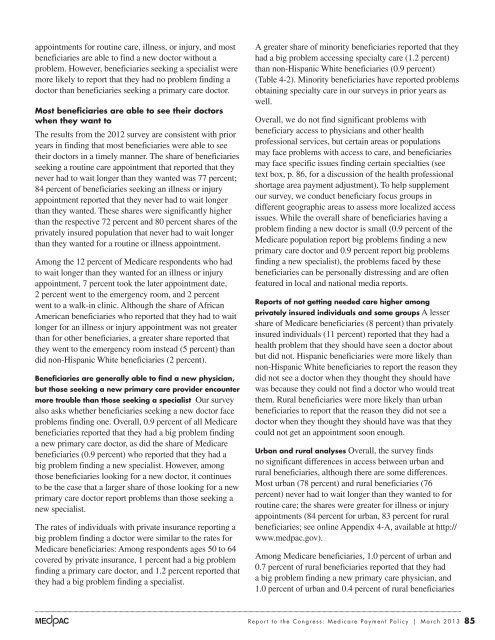Medicare Payment Policy
Medicare Payment Policy
Medicare Payment Policy
Create successful ePaper yourself
Turn your PDF publications into a flip-book with our unique Google optimized e-Paper software.
appointments for routine care, illness, or injury, and most<br />
beneficiaries are able to find a new doctor without a<br />
problem. However, beneficiaries seeking a specialist were<br />
more likely to report that they had no problem finding a<br />
doctor than beneficiaries seeking a primary care doctor.<br />
Most beneficiaries are able to see their doctors<br />
when they want to<br />
The results from the 2012 survey are consistent with prior<br />
years in finding that most beneficiaries were able to see<br />
their doctors in a timely manner. The share of beneficiaries<br />
seeking a routine care appointment that reported that they<br />
never had to wait longer than they wanted was 77 percent;<br />
84 percent of beneficiaries seeking an illness or injury<br />
appointment reported that they never had to wait longer<br />
than they wanted. These shares were significantly higher<br />
than the respective 72 percent and 80 percent shares of the<br />
privately insured population that never had to wait longer<br />
than they wanted for a routine or illness appointment.<br />
Among the 12 percent of <strong>Medicare</strong> respondents who had<br />
to wait longer than they wanted for an illness or injury<br />
appointment, 7 percent took the later appointment date,<br />
2 percent went to the emergency room, and 2 percent<br />
went to a walk-in clinic. Although the share of African<br />
American beneficiaries who reported that they had to wait<br />
longer for an illness or injury appointment was not greater<br />
than for other beneficiaries, a greater share reported that<br />
they went to the emergency room instead (5 percent) than<br />
did non-Hispanic White beneficiaries (2 percent).<br />
Beneficiaries are generally able to find a new physician,<br />
but those seeking a new primary care provider encounter<br />
more trouble than those seeking a specialist Our survey<br />
also asks whether beneficiaries seeking a new doctor face<br />
problems finding one. Overall, 0.9 percent of all <strong>Medicare</strong><br />
beneficiaries reported that they had a big problem finding<br />
a new primary care doctor, as did the share of <strong>Medicare</strong><br />
beneficiaries (0.9 percent) who reported that they had a<br />
big problem finding a new specialist. However, among<br />
those beneficiaries looking for a new doctor, it continues<br />
to be the case that a larger share of those looking for a new<br />
primary care doctor report problems than those seeking a<br />
new specialist.<br />
The rates of individuals with private insurance reporting a<br />
big problem finding a doctor were similar to the rates for<br />
<strong>Medicare</strong> beneficiaries: Among respondents ages 50 to 64<br />
covered by private insurance, 1 percent had a big problem<br />
finding a primary care doctor, and 1.2 percent reported that<br />
they had a big problem finding a specialist.<br />
A greater share of minority beneficiaries reported that they<br />
had a big problem accessing specialty care (1.2 percent)<br />
than non-Hispanic White beneficiaries (0.9 percent)<br />
(Table 4-2). Minority beneficiaries have reported problems<br />
obtaining specialty care in our surveys in prior years as<br />
well.<br />
Overall, we do not find significant problems with<br />
beneficiary access to physicians and other health<br />
professional services, but certain areas or populations<br />
may face problems with access to care, and beneficiaries<br />
may face specific issues finding certain specialties (see<br />
text box, p. 86, for a discussion of the health professional<br />
shortage area payment adjustment). To help supplement<br />
our survey, we conduct beneficiary focus groups in<br />
different geographic areas to assess more localized access<br />
issues. While the overall share of beneficiaries having a<br />
problem finding a new doctor is small (0.9 percent of the<br />
<strong>Medicare</strong> population report big problems finding a new<br />
primary care doctor and 0.9 percent report big problems<br />
finding a new specialist), the problems faced by these<br />
beneficiaries can be personally distressing and are often<br />
featured in local and national media reports.<br />
Reports of not getting needed care higher among<br />
privately insured individuals and some groups A lesser<br />
share of <strong>Medicare</strong> beneficiaries (8 percent) than privately<br />
insured individuals (11 percent) reported that they had a<br />
health problem that they should have seen a doctor about<br />
but did not. Hispanic beneficiaries were more likely than<br />
non-Hispanic White beneficiaries to report the reason they<br />
did not see a doctor when they thought they should have<br />
was because they could not find a doctor who would treat<br />
them. Rural beneficiaries were more likely than urban<br />
beneficiaries to report that the reason they did not see a<br />
doctor when they thought they should have was that they<br />
could not get an appointment soon enough.<br />
urban and rural analyses Overall, the survey finds<br />
no significant differences in access between urban and<br />
rural beneficiaries, although there are some differences.<br />
Most urban (78 percent) and rural beneficiaries (76<br />
percent) never had to wait longer than they wanted to for<br />
routine care; the shares were greater for illness or injury<br />
appointments (84 percent for urban, 83 percent for rural<br />
beneficiaries; see online Appendix 4-A, available at http://<br />
www.medpac.gov).<br />
Among <strong>Medicare</strong> beneficiaries, 1.0 percent of urban and<br />
0.7 percent of rural beneficiaries reported that they had<br />
a big problem finding a new primary care physician, and<br />
1.0 percent of urban and 0.4 percent of rural beneficiaries<br />
Report to the Congress: <strong>Medicare</strong> <strong>Payment</strong> <strong>Policy</strong> | March 2013<br />
85


